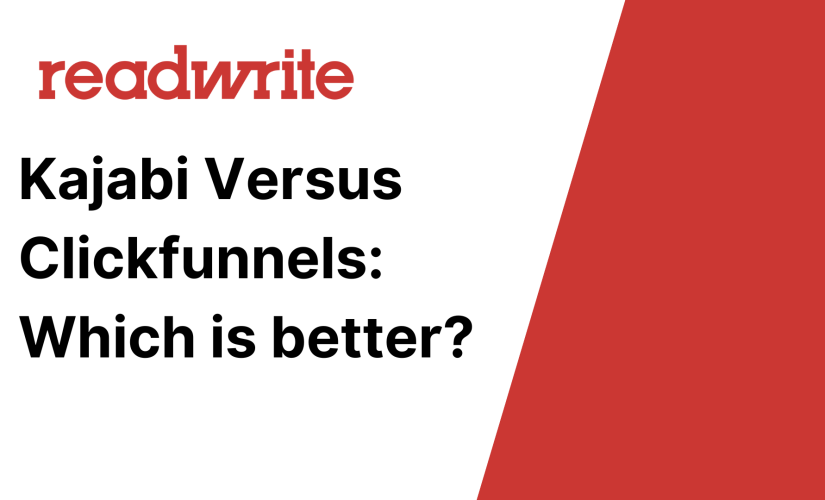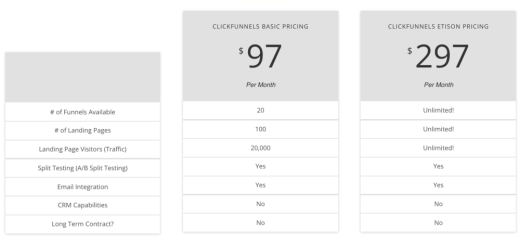Kajabi versus ClickFunnels: Which is Better?
Kajabi versus ClickFunnels: Which is Better?

In today’s fast-paced digital landscape, online entrepreneurs and businesses have increasingly turned to powerful platforms such as Kajabi and ClickFunnels to build and manage their sales funnels, streamline marketing campaigns, and enhance customer engagement.
With each platform offering a unique blend of features and benefits, the choice between Kajabi and ClickFunnels has been a point of continuous debate for both industry experts and everyday users. In this article, we delve into and juxtapose these two formidable platforms, evaluating their strengths and weaknesses in a comprehensive comparison to help you make the most informed decision for your business.
From the ease of use and integration capabilities to the pricing structure and customer support, get ready to gain valuable insights and discover which platform – Kajabi or ClickFunnels – is the right fit for your online ventures.
What is Kajabi

Kajabi is an all-in-one platform that allows users to create, market, and sell online courses and digital products. It provides a range of tools, including website building, email marketing, and content management.
Kajabi aims to simplify the process of scaling digital businesses by offering a comprehensive solution for entrepreneurs and experts in various fields.
What is ClickFunnels
ClickFunnels is a software platform designed for creating effective sales funnels and marketing campaigns. It simplifies the process of building, launching, and managing online marketing funnels by providing pre-built templates and automation tools.
The primary goal of ClickFunnels is to help businesses generate leads, drive sales, and maximize profits through customized, user-friendly marketing efforts.
Why Use?
Kajabi and ClickFunnels are both popular all-in-one platforms that help businesses and entrepreneurs build online courses, membership sites, and sales funnels.
While both platforms have similar purposes, they have different features and use-cases, catering to various target audiences and business objectives. Here are some example use-cases for each platform:
Kajabi:
1. Online course creation and hosting: Kajabi empowers educators and subject matter experts to create and host online courses. With its built-in video hosting, quizzes, exams, and progress tracking features, Kajabi is an excellent platform for building, selling, and managing online courses.
2. Membership websites: Businesses or individuals looking to create a membership-based platform can use Kajabi to set up a dedicated website that provides exclusive content, resources, or community access (e.g., forums, discussion boards) to paying members.
3. Coaching and consulting: Professional consultants or coaches can use Kajabi to create an online presence, promote their services, and offer multiple coaching packages. They can manage their clients, deliver content, and receive payments, all in one place.
4. Digital product selling: Creators of digital products such as eBooks, templates, or graphics can use Kajabi to set up a digital storefront and manage sales and delivery of their products.
ClickFunnels:
1. Building sales funnels: ClickFunnels primarily focuses on facilitating the creation and optimization of various types of sales funnels. Businesses can design landing pages, create product offers, build effective sales pages, and manage the entire customer journey through multiple funnel stages.
2. Webinar funnels: ClickFunnels allows users to create webinars, both live and automated, to promote their products, services, or online courses. With its built-in email marketing and autoresponder integration, ClickFunnels makes it easy to nurture leads, send reminders, and follow up with potential customers.
3. Lead generation: ClickFunnels excels in lead generation for businesses. Users can quickly build opt-in pages and lead magnets that capture visitors’ contact information and can be integrated with popular email marketing tools.
4. Affiliate marketing: ClickFunnels offers its own affiliate program, which enables users to promote and sell their products and earn commission for every successful sale, using a variety of affiliate marketing tools and resources.
In summary, Kajabi is an excellent platform for those looking to create and sell digital products and online courses, while ClickFunnels’ main strength lies in building sales funnels and lead generation strategies. Both platforms have overlapping features but cater to different business needs and objectives.
Features
Kajabi:
Kajabi is an all-in-one platform designed to help businesses build, market, and sell online courses and digital products. It offers a comprehensive suite of tools and features that aims to streamline the process of creating and managing an online business.
Some of the main features of Kajabi include:
- Course Creation: Kajabi enables users to create and customize online courses using a user-friendly interface. It offers various templates to help users organize and present their content in an engaging manner. Additionally, Kajabi supports diverse content types such as video, audio, text, and quizzes to provide a rich learning experience.
- Website Builder: Kajabi comes with a robust website builder, allowing users to create a fully customizable and professional-looking website without needing any coding experience. It provides a variety of templates, themes, and design elements, along with the ability to add custom domains and use responsive designs to ensure your site looks great on any device.
- Marketing and Sales Tools: Kajabi offers an integrated suite of marketing and sales tools designed to help users generate leads, build an email list, and convert prospects into paying customers. Some notable features include email marketing, landing pages, sales funnels, automations, and analytics to monitor and optimize your marketing efforts. Plus, it offers seamless integration with popular payment gateways like Stripe and PayPal.
- Customer Relationship Management (CRM): Kajabi provides an inbuilt CRM system to help businesses manage and communicate with their customers, offering insights into customer actions, purchases, and engagement. This enables users to segment their audience, send targeted messages, and ultimately improve their customer retention and satisfaction.
ClickFunnels:
ClickFunnels, on the other hand, is a platform focused on creating effective sales funnels and landing pages. It offers a range of tools designed to help businesses convert website visitors into leads, prospects, and paying customers.
Here are some of the main features of ClickFunnels:
- Funnel Builder: ClickFunnels is primarily known for its intuitive drag-and-drop funnel builder, which allows users to create high-converting sales funnels with ease. Users can choose from a range of pre-built templates or create custom funnels from scratch, tailoring them to their specific needs and goals.
- Landing Page Builder: The platform includes a versatile landing page builder, enabling users to create visually appealing and optimized landing pages that help drive conversions. With its vast selection of templates and design elements, ClickFunnels simplifies the process of building engaging landing pages without the need for coding or design experience.
- Marketing and Sales Automation: ClickFunnels offers marketing and sales automation tools for nurturing leads and streamlining the sales process. This includes email marketing, SMS messaging, automated follow-ups, and integrations with popular CRM and email marketing platforms. Additionally, the platform provides an affiliate management system to help businesses leverage affiliate marketing to grow their customer base.
- Payment Integrations and Order Forms: ClickFunnels makes it easy to set up and manage online payments with its built-in payment integrations like Stripe, PayPal, and others. Users can create secure order forms, upsells, downsells, and one-click purchases, simplifying the buying process and increasing the potential for revenue generation.
Overall, Kajabi and ClickFunnels cater to different aspects of the online business ecosystem. Kajabi is better suited for those looking to create and sell online courses or digital products, while ClickFunnels is focused on helping businesses build and optimize their sales funnels and marketing efforts.
Pros n Cons
Kajabi Pros:
1. Comprehensive Solution:
- Kajabi is an all-in-one platform that provides website building, marketing, and course creation tools, making it easy to create, market, and sell online courses and memberships.
2. Professional Templates:
- Kajabi offers a variety of pre-built, customizable templates suitable for various industries and needs, giving users a professional and easy-to-use starting point.
3. Integrations:
- Kajabi integrates with many third-party tools, including popular payment gateways, email marketing services, and CRM platforms, allowing users to streamline their workflows.
4. Built-in Automation:
- With Kajabi, users can create automated marketing campaigns, email sequences, and other automation features to save time and improve customer communication.
5. Community Support:
- Kajabi has a strong user community and offers various resources, including webinars, tutorial videos, and a responsive support team.
Kajabi Cons:
1. Pricing:
- Kajabi’s pricing plans can be relatively expensive, especially for small businesses or individuals just starting out in online course creation.
2. Limited Customization:
- While the templates provided by Kajabi are professional, they can be somewhat restrictive in terms of customization.
3. Steeper Learning Curve:
- Kajabi offers many features but can be overwhelming for new users. It may take some time to learn to navigate the platform effectively.
4. Limited SEO Optimization:
- Kajabi’s platform doesn’t provide extensive SEO optimization tools, which can limit the organic search traffic potential for courses and websites.
ClickFunnels Pros:
1. Easy Funnel Creation:
- ClickFunnels simplifies the process of creating sales funnels, allowing even users with limited technical knowledge to design effective marketing campaigns.
2. Drag-and-Drop Editor:
- ClickFunnels offers a user-friendly drag-and-drop editor for designing landing pages, making customization easy and accessible.
3. Integrations:
- ClickFunnels integrates with various third-party tools, such as email marketing services, CRM systems, and payment gateways, which can enhance user workflows.
4. A/B Testing:
- ClickFunnels provides built-in A/B testing tools to help users optimize their funnels and improve conversion rates.
5. Extensive Training Resources:
- ClickFunnels offers numerous training resources, including the Funnel Hacking Live event, the Funnel Hacker’s Cookbook, and a dedicated community forum.
Clickfunnels Cons:
1. Pricing:
- ClickFunnels is relatively expensive, with the entry-level plan offering limited features and higher-tier plans offering more options at a higher cost.
2. Limited Website Building Capability:
- ClickFunnels focuses primarily on landing pages and sales funnel creation and is not designed as a full-scale website builder, limiting its scope of use.
3. Customer Support:
- Some users have reported dissatisfaction with ClickFunnels’ customer support, stating that responses can be slow or unhelpful.
4. Upsells:
- ClickFunnels frequently promotes additional products and upsells, which can be annoying for users looking for a straightforward sales funnel solution.
5. Limited Customization:
- While the drag-and-drop editor makes landing page design easy, it can be somewhat restrictive in terms of design customization, particularly for more advanced users.
How to setup Kajabi
Step 1: Sign up for a Kajabi account
- Visit Kajab’s website at https://www.kajabi.com/.
- Click on the “Get Started” or “Start Free Trial” button.
- Fill out the required information, including your name, email address, and password.
- Click “Create your Kajabi account” to complete the registration process.
Step 2: Choose a plan
- Review Kajabi’s pricing options to determine which plan best suits your needs.
- Select a plan, which can be changed at any time, by clicking on the “Choose Plan” button below your preferred option.
- Fill out your payment details to activate the plan.
Step 3: Customize your site
- Log in to your Kajabi dashboard.
- Click “Website” in the left-hand menu and then “Design Your Site.”
- Choose a theme for your site and adjust colors, fonts, and other visual elements to match your brand.
- Create and customize pages (such as Home, About, Contact, etc.) by clicking “Pages” in the left-hand menu, and then “Add New Page.”
Step 4: Create online courses or products
- Click “Products” in the left-hand menu of your dashboard.
- Click “Create a new product” and choose a product template (such as mini-course, online course, or community).
- Provide a name and description for your product and click on “Create a Product.”
- Customize your product’s content by adding sections, lectures, and other materials.
- Configure your product’s settings, including pricing, access rules, and integrations with other tools.
Step 5: Set up payment and marketing options
- Click “Settings” in the left-hand menu and then “Payments” to connect Kajabi to your preferred payment gateway (e.g., Stripe, PayPal).
- Customize your checkout settings, such as currency, taxes, and legal agreements.
- Set up email marketing, if desired, by clicking “Email” in the left-hand menu and connecting Kajabi to an email service provider such as Mailchimp or ActiveCampaign.
- Create and customize marketing funnels, also known as pipelines, to automate your sales process by clicking “Pipelines” in the left-hand menu and then “Create New Pipeline.”
After completing the steps above, your Kajabi site will be ready to launch. Share the link to your site with your audience, promote your courses, and watch your online business grow!
How to setup ClickFunnels
Setting up ClickFunnels is a straightforward process that can be broken down into the following steps:
Step 1: Sign up for ClickFunnels
- Begin by signing up for a ClickFunnels account on their website (www.clickfunnels.com). You can start with a 14-day free trial to test the platform and decide which plan suits your needs.
- Once you’ve chosen a plan, create your account by providing your email address and setting a password.
Step 2: Personalize your account
- After signing up, personalize your account by adding your logo, setting your time zone, and connecting your domain (optional). Connecting your domain will enable you to have your funnels appear on your website.
Step 3: Choose your funnel
- Click on the “Funnels” tab on the ClickFunnels dashboard. Here, you can either create a new funnel or select from pre-built industry-specific templates.
- Click on the “Build Funnel” button and choose “Create New Funnel.” You will need to select whether you want to create a sales funnel, generate leads, or host a webinar.
Step 4: Name your funnel
- Give your funnel a descriptive name and add a short tagline (optional). This will help you easily identify your funnel in the future.
Step 5: Customize your funnel
- Once you have chosen the type of funnel you want, you can start customizing it to suit your needs. This includes selecting the right pages to use, the layout, images, text, and more. ClickFunnels provides a drag and drop feature to make this process as easy as possible.
- You can customize each page in your funnel by clicking on the “Edit Page” button. When you’re finished making changes to a specific page, click on the “Save” button.
Step 6: Connect email marketing and payment gateways
- To maximize the effectiveness of your funnels, you should connect them to your email marketing platform and payment gateways.
- Go to “Integrations” in the menu to link email marketing tools like MailChimp, Aweber, or ActiveCampaign. You can also connect your preferred payment gateway, including Stripe, PayPal, and others.
Step 7: Set up automation and email sequences
- With your integrations set up, create automation rules for your funnel by clicking on the “Automation” tab. This allows you to send follow-up emails, create tasks, and more based on user actions. You can automate emails to be sent after a specific amount of time or choose a trigger based on the actions taken by the users.
Step 8: Test and launch your funnel
- Before launching your funnel, make sure you’ve tested the funnel thoroughly. Double-check your connections, integrations, and email sequences. You can use ClickFunnels’ built-in test mode or conduct live tests with minimal transactions.
- Once you’re satisfied with your funnel setup, click “Publish” to launch your funnel. You can now start sharing the URL with your target audience and tracking your funnel’s performance.
By following these steps, you can have your ClickFunnels fully set up and ready to start generating leads and driving sales for your business.
Main Differences

Kajabi and ClickFunnels are two popular online platforms designed to help business owners and entrepreneurs create, manage, and grow their online presence.
While both platforms offer a range of features and tools to help users succeed, they have different approaches and cater to slightly different needs.
Kajabi is primarily focused on creating and selling online courses, memberships, and digital products. It offers a robust range of features to help users create attractive and engaging websites, build comprehensive sales funnels, and integrate with various marketing tools and payment processors.
In addition to that, Kajabi has a built-in LMS (Learning Management System) which allows creators to deliver high-quality educational content while also providing excellent user experience for their customers.
This makes Kajabi an ideal choice for those looking to create and sell online courses or memberships.
On the other hand, ClickFunnels is specifically designed to help businesses build effective sales funnels to convert website visitors into paying customers. The platform offers a simple drag-and-drop interface that allows users to create a variety of sales funnel types, including opt-in funnels, product launch funnels, webinar funnels, and membership sites.
It also includes email marketing integrations, an affiliate management system, and a host of other marketing tools aimed at increasing conversions and generating leads. With its more comprehensive focus on the entire sales process, ClickFunnels is better suited for businesses that are looking to optimize their sales and lead generation efforts, rather than creating educational content.
In summary, both Kajabi and ClickFunnels serve specific purposes and cater to different target audiences. Kajabi is the better choice for those focusing on creating and selling online courses, digital products, and memberships with an emphasis on delivering high-quality educational content.
Meanwhile, ClickFunnels is more geared towards businesses and entrepreneurs who want an all-in-one platform for building sales funnels, lead generation, and email marketing. The choice between the two platforms should ultimately depend on the individual user’s needs and goals.
Pricing Comparison
Kajabi and ClickFunnels are two popular online platforms that help businesses create, market, and sell their products or services. Both platforms offer different pricing plans to cater to a variety of users, but they each have their own advantages and features.
Here’s a comparison of their pricing:
Kajabi’s Pricing Plans:
- Basic Plan:
- $ 149 per month (billed annually) or $ 199 per month (billed monthly)
- 3 products and 3 pipelines
- 1,000 active members
- 1 website and 1 admin user
- 0% transaction fees
- Unlimited landing pages and marketing emails
- Webinars and events, chat support, and more
- $ 199 per month (billed annually) or $ 299 per month (billed monthly)
- 15 products and 15 pipelines
- 10,000 active members
- 1 website and up to 10 admin users
- 0% transaction fees
- Unlimited landing pages and marketing emails
- Advanced features like 24/7 chat support, automated webinars, and more
- $ 399 per month (billed annually) or $ 499 per month (billed monthly)
- 100 products and 100 pipelines
- 20,000 active members
- 1 website and up to 25 admin users
- 0% transaction fees
- Unlimited landing pages and marketing emails
- Premium features like 24/7 phone support, affiliate program, and more
ClickFunnels Pricing:
ClickFunnels offers two main pricing plans:
- Standard Plan:
- $ 97 per month Features include:
- 20 sales funnels
- 100 pages
- 1 user
- 3 payment gateways
- 3 domains
- Unlimited leads
- Chat support
- $ 297 per month Features include (in addition to the Standard Plan):
- Unlimited sales funnels
- Unlimited pages
- 3 users
- 9 payment gateways
- 9 domains
- Priority chat support
- Follow-up funnels (email automation)
- Weekly peer review hackathons
![Kajabi versus ClickFunnels: Which is Better? | DeviceDaily.com ClickFunnels Pricing Guide [2020]: 7 ClickFunnels Pricing Plans — EZJ Online | DeviceDaily.com](https://www.devicedaily.com/wp-content/uploads/2023/07/09-Kajabi-versus-ClickFunnels-Which-is-Better.png)
In conclusion, the pricing for Kajabi and ClickFunnels varies on what you need and what features you are looking for. If you’re mainly focused on creating sales funnels and email automation, ClickFunnels might be the better option.
However, if you need a more comprehensive platform for creating online courses, memberships, and an all-in-one marketing and sales platform, Kajabi might be a better fit. It’s important to evaluate your needs and goals when choosing between these two platforms.
Frequently Asked Questions
Q: What is Kajabi?
A: Kajabi is an all-in-one online platform designed primarily for creating, marketing, and selling online courses, digital products, and membership sites. It comes with specific features to help users create content, build landing pages, manage email marketing, and much more.
Q: What is ClickFunnels?
A: ClickFunnels is a platform that focuses on creating sales funnels, allowing users to design a series of pages, automate email marketing, and sell digital or physical products. Its primary goal is to help businesses increase leads, generate sales, and simplify the sales process online.
Q: How do Kajabi and ClickFunnels differ in terms of functionality?
A: While Kajabi is specifically designed for creators who want to sell digital products, courses, and membership sites, ClickFunnels’ main focus is on building sales funnels that help convert leads into customers. Both platforms have features like landing page builders and email marketing tools, but the main distinction lies in their target audience and use cases.
Q: Can Kajabi and ClickFunnels be used together?
A: Yes, both platforms can be integrated to complement each other’s functionalities. For example, Kajabi can be used to create and market the digital content, while ClickFunnels can be employed to design powerful sales funnels to sell the produced courses or digital products.
Q: Is either platform better for certain industries?
A: Kajabi tends to be better suited for educational content creators like coaches, consultants, and course creators. On the other hand, ClickFunnels is more versatile and can be used across various industries, primarily focusing on converting leads into customers using sales funnels.
Q: How do the pricing options of Kajabi and ClickFunnels compare?
A: Both platforms offer multiple pricing plans to choose from, depending on the needs of users. However, Kajabi’s plans typically start at a higher price point than ClickFunnels. It’s essential to analyze the features included in each pricing plan to determine the most suitable option for your business.
Q: Are there any free trials available for Kajabi and ClickFunnels?
A: Yes, both Kajabi and ClickFunnels usually offer a free trial period for prospective users to test out the platform and decide if it’s the right fit for their businesses. Kajabi typically provides a 14-day free trial, while ClickFunnels may offer a 14-day or 30-day free trial depending on the available promotions.
Conclusion
In conclusion, the choice between Kajabi and ClickFunnels ultimately depends on the specific needs and goals of your online business. Both platforms offer powerful and versatile solutions for digital entrepreneurs, with Kajabi focusing on creating and selling comprehensive online courses, memberships, and digital products, while ClickFunnels emphasizes on building dynamic sales funnels that convert visitors into customers.
Consider your business’s primary objective before making a decision: if your focus is on delivering valuable content and creating engaging online learning experiences, Kajabi might be the better option.
On the other hand, if your priority is driving sales and increasing conversion rates through highly-targeted marketing campaigns, ClickFunnels may be a more suitable choice. Moreover, it’s important to weigh the pros and cons of each platform, including factors like pricing, customization options, features, integrations, ease of use, and customer support.
Taking the time to thoroughly assess the advantages and disadvantages of Kajabi and ClickFunnels will ensure that you make an informed decision and select the platform that best aligns with your business’s unique needs and aspirations.
Whichever platform you choose, both Kajabi and ClickFunnels have the potential to significantly contribute to your online success by streamlining your sales funnels, enhancing your digital presence, and ultimately, boosting your bottom line.
The post Kajabi versus ClickFunnels: Which is Better? appeared first on ReadWrite.
(18)






![Kajabi versus ClickFunnels: Which is Better? | DeviceDaily.com Kajabi Pricing [Jun 2023]: Which Plan for What Audience? | DeviceDaily.com](https://www.devicedaily.com/wp-content/uploads/2023/07/08-Kajabi-versus-ClickFunnels-Which-is-Better.png)
